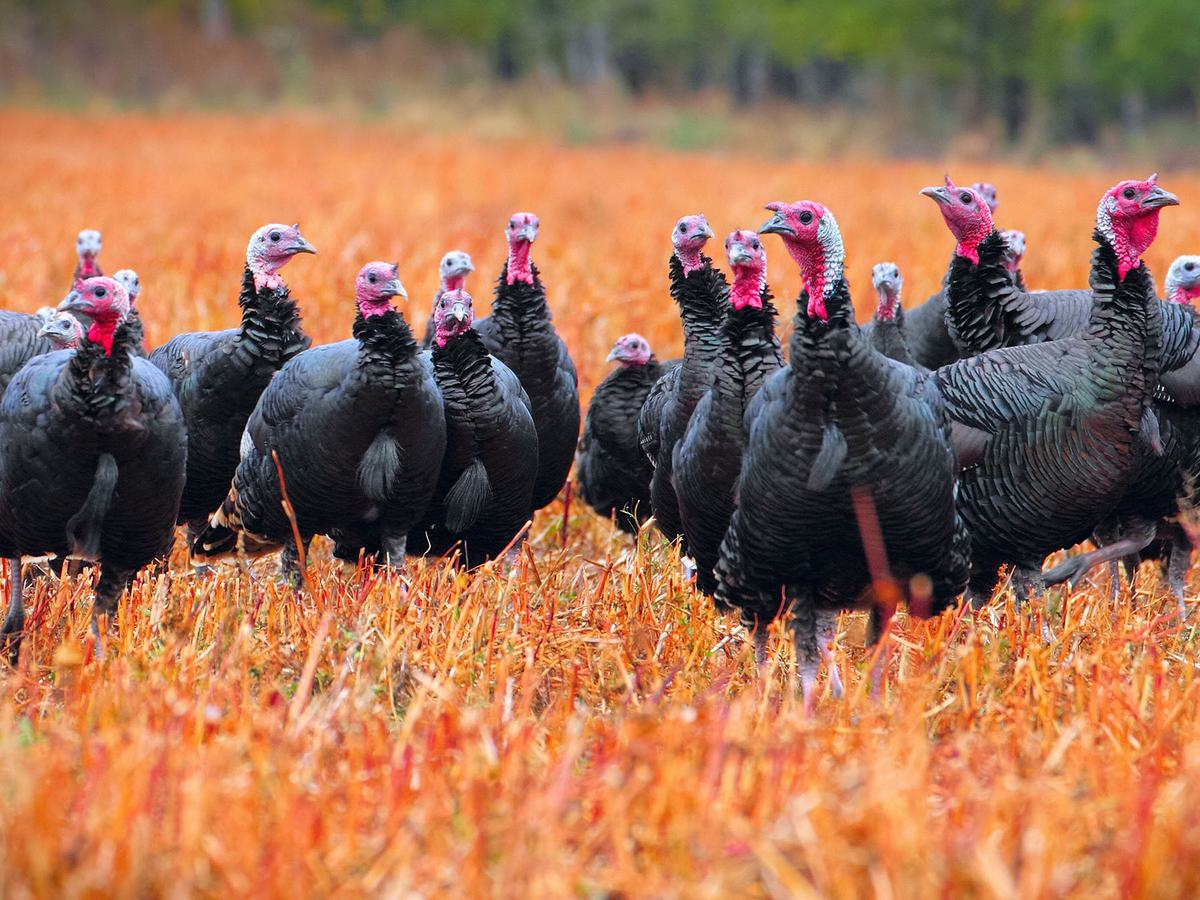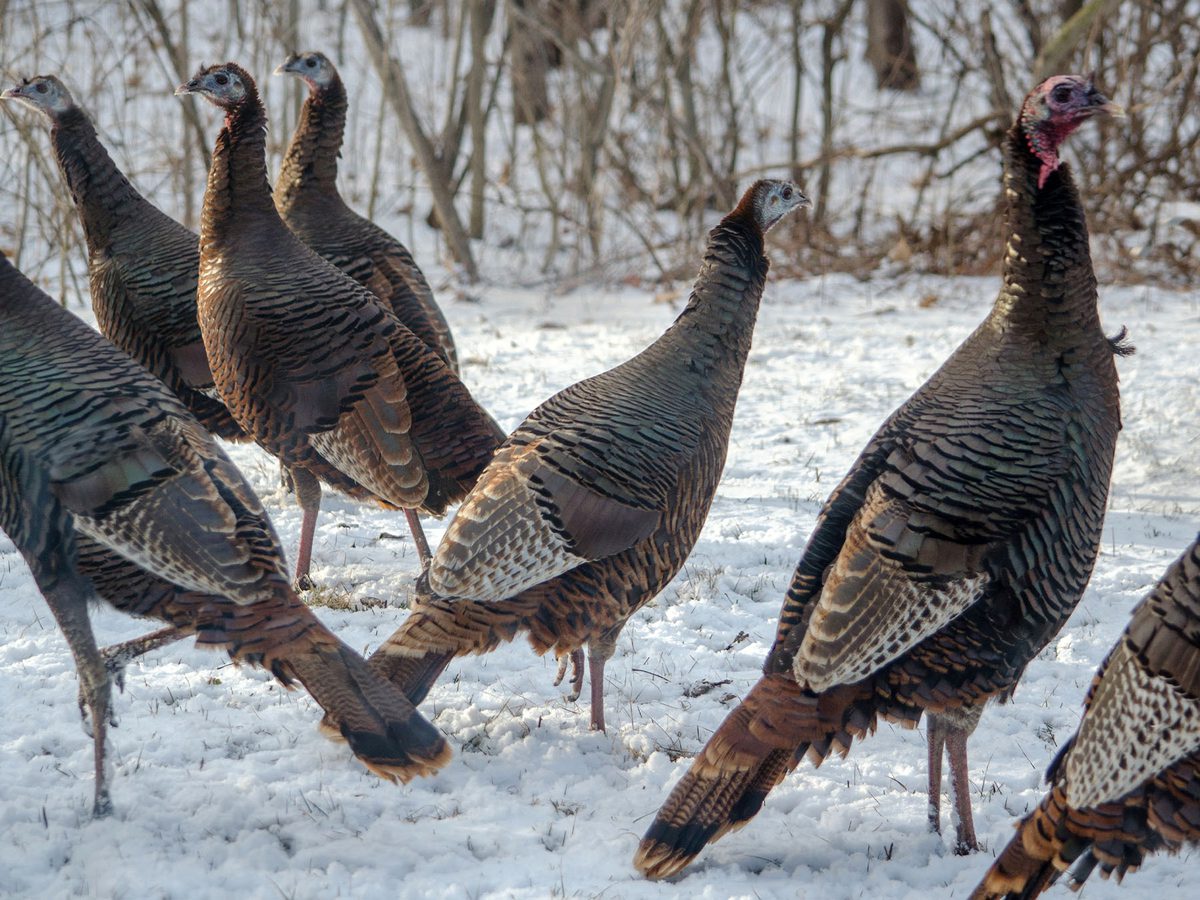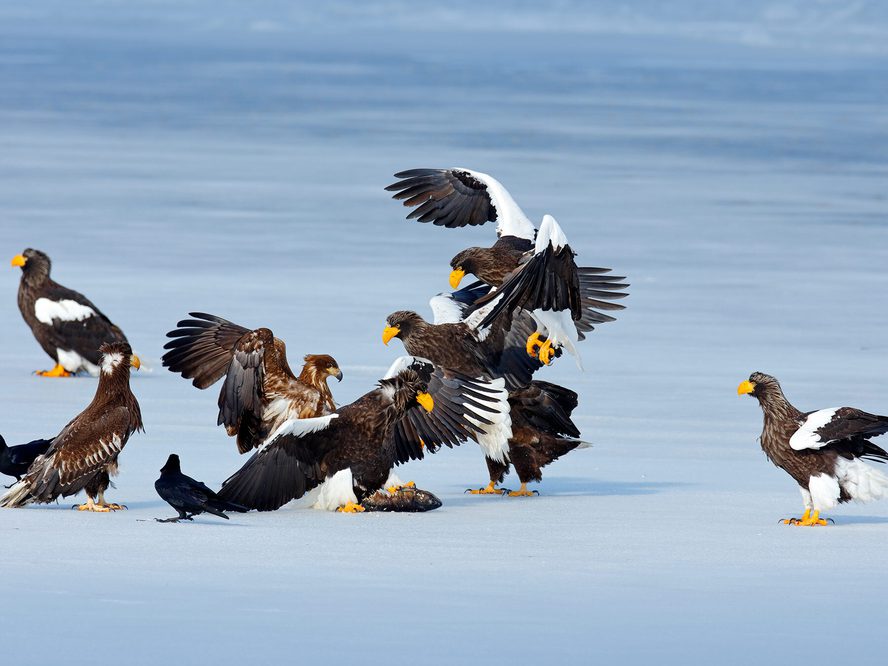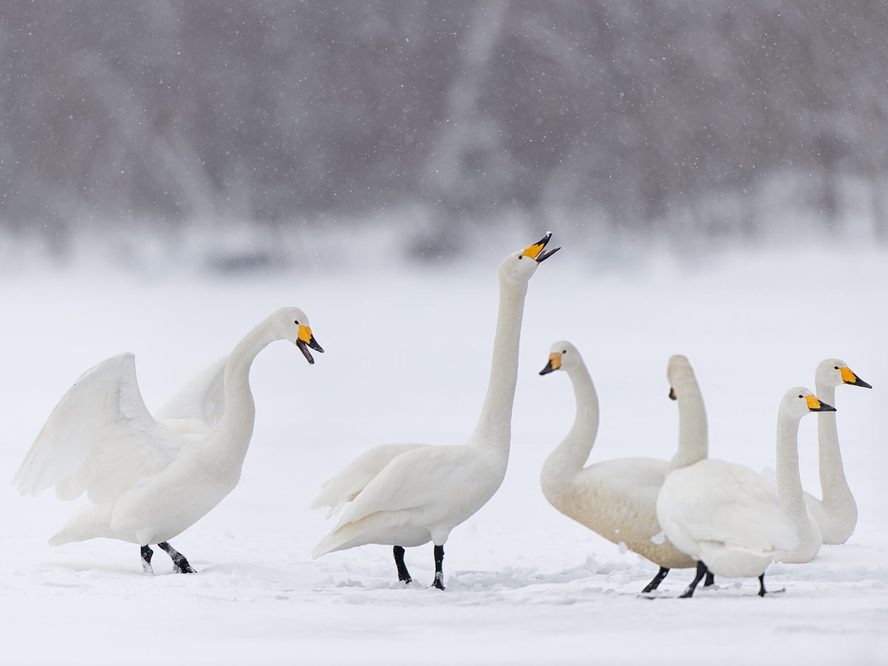Jump to Section
What Do You Call a Group of Turkeys? From 'Gangs' to 'Rafts
Last updated: 20 November 2023

In 1782, the turkey narrowly missed out on the bald eagle for being named the national bird of the United States. However, as a symbol of family gatherings and gratitude, the appeal of the turkey throughout the country remains strong. Groups of wild turkeys have roamed North America for centuries and since being domesticated, they also rank as one of the most widespread poultry species kept by farmers. But is a group of turkeys referred to as a flock, a colony, or something different?
Gregarious, sociable birds and turkeys are often gathered in sizable groups, both in the wild and when raised domestically. There isn’t one single name to describe these groups, instead, they vary according to circumstances and include flock, gang, rafter, gaggle, and even posse.
Keep reading to find out when different collective terms for a gathering of turkeys should be used, as well as some fascinating insight into how these noisy, iconic poultry organize themselves within their social groups.

Gregarious, sociable birds, turkeys are often seen gathered in sizable groups, both in the wild and when they are raised domestically
Terminology for Groups of Turkeys
Is it a flock, a gaggle, a rafter, a gang or a brood of turkeys? Well, the answer is, that all of the above are correct, but each term is used in slightly different contexts. We’ll be looking at each one below, so read on to learn more.
General Term
When talking about a gathering of turkeys, both in the wild and on a turkey farm or homestead, it’s fine to simply call them a flock.
Specific Terms
Historically, groups of domesticated turkeys were known as rafters. This term is not in common usage today, although it is still used among turkey farmers. Although it’s unclear exactly when this term originated, one theory is that the name comes from a turkey’s habit of roosting up high overnight, in the rafters or eaves of a barn, or in the wild in the branches of a tree.
Another name for a gathering of turkeys is a ‘gang’, or less commonly a ‘mob’. This refers to the noisy and sometimes intimidating behavior when large groups of young and older male turkeys assemble.
Occasionally a group of noisy turkeys may also be called a ‘gaggle’, calling out the loud, gobbling sounds that are characteristic of a large gathering of turkeys (and geese!).
In the wild, mixed groups of turkeys are sometimes also known as ‘runs’, while groups that consist solely of adult males (known as ‘toms’) might be referred to as ‘posses’.
Juvenile Groups
Groups containing young turkeys are often referred to as broods and consist of a female, with several young.
Other terms for a group of Turkeys
A brood of turkeys
A crop of turkeys
A death row of turkeys
A dole of turkeys
A dule of turkeys
A gang of turkeys
A herd of turkeys
A mob of turkeys
A muster of turkeys
A posse of turkeys
A raffle of turkeys
A raft of turkeys
A school of turkeys
A Thanksgiving of turkeys
A run of (wild) turkeys
A bachelor group of (wild male) turkeys
A posse of (wild male) turkeys
A standout term here is a death row of turkeys, and you might have already guessed why and when this term might be used! According to the University of Illinois, some 46 million turkeys are eaten on Thanksgiving, 22 million on Christmas and 19 million at Easter.

A female Wild Turkey with her young are often referred to as a brood
Why Different Names?
Collective nouns for birds are useful for describing the behavior of a group, giving clarity when recording sightings. There are different names for groups of geese, for example, depending on whether they are flying, on land, or on the water. Learn more about collective nouns used to describe turkeys below.
The generic collective noun for turkeys is flock, used as a general term for groups of several other bird species including ducks in flight, gulls and starlings. It simply means a number of birds that have congregated together.
Although the origins of ‘rafter’ as a collective noun for turkeys are unclear, it’s believed to refer to their off-ground roosting habits in barns, trees and beams. Another suggested meaning is that the word ‘rafter’ is derived from the Greek word ‘‘rhaptein’ which means ‘stitched together’. When wild turkey flocks move together, their feathers appear closely woven together.

The generic collective noun for turkeys is flock, used as a general term for groups of several other bird species
The Social Structure of Turkey Groups
Turkeys have a very well-defined social hierarchy, with specific roles and groupings according to gender and age. Read on to learn more about the fascinating social pecking order of turkeys in the wild.
Wild turkeys have a very clear social structure, with each level being dominant over the layer below. During the breeding season, this dominance hierarchy is particularly obvious, with alpha males at the head. The most aggressive alpha males may even attempt to dominate humans that they see as a competitor, using pecking and physical intimidation techniques.
Larger, more confrontational turkeys have a higher status than more subordinate, smaller birds. This order is established from a young age, and only changes when an older dominant male becomes weak or dies, and his position is then assumed by a younger, fitter bird.
Wild turkey flocks are usually segregated by sex and age class into four groupings: adult gobblers, jake-only flocks, adult hens without any offspring, and adult hens with young chicks. Pairs may be seen associating in spring, and it’s not unusual for hens to break away from groups during the breeding season to establish safe spots to nest alone.

Wild Turkeys during the breeding season. During the breeding season, this dominance hierarchy is particularly obvious, with alpha males at the head
Turkeys on the Farm vs. Wild Turkeys
There are between 6 and 7 million wild turkeys living in the US, present in every state except Alaska. In comparison, around 210 million turkeys are estimated to be being raised in captivity on around 2,500 farms across the country. Read on to learn more about the differences in how they live.
In the wild, turkey groups form naturally, with well-established pecking orders based on age, size and dominant status. They are particularly intelligent birds, and their interactions and role within their flock are evident when they are foraging for food or contending for roosting spots.
Turkeys raised commercially are separated into male and female groups after hatching, and their entire social system is structured according to their age and life stage. Turkey eggs are brooded in incubators, rather than by brooding females, and the natural hierarchy of mixed groups is absent.
Observing Turkey Groups in Nature
Wild turkeys are most common in the central and eastern parts of the United States, especially Alabama, Texas, Missouri, Kansas, and Wisconsin. For tips on spotting turkey groups in the wild, please read on.
Turkeys thrive in a wide range of habitats, including woodlands, open pastures and agricultural fields. Woodlands provide useful cover from predators while foraging, and perching spots for overnight roosting. Grasslands, mountain slopes, and riverside landscapes offer good chances of sightings, while fields lined by nut trees, particularly oak, beech and hickory, are prime foraging spots.
At dusk, wild turkeys ascend to roosting spots off the ground, particularly in the branches of trees around the edges of fields or pastures. The best time to look out for a rafter of turkeys is in the early evening, as they rise off the ground and prepare to rest for the night.

A pair of Wild Turkeys roosting. At dusk, wild turkeys ascend to roosting spots off the ground, particularly in the branches of trees around the edges of fields or pastures
The Turkey's Role in Ecosystems and Culture
Turkeys represent abundance, gratitude and a sense of close family, and have been a central part of Thanksgiving celebrations since the 1800s. Read on to learn more about the economic and cultural significance of turkeys.
Domestic and commercial turkeys make a significant impact on the US economy, with nearly 400,000 jobs and a direct financial contribution of around $36 billion annually.
Turkeys are not only valued as a source of food but have wider cultural significance. Their feathers were used in Native American art, and their bones served as tools and decorations. Turkey feathers are also a staple of flamboyant fashion, including fans, feather boas, and costume accessories.
Conservation and Human Interaction
By the 1900s, North America’s wild turkey population was in trouble. Poaching and habitat destruction have reduced numbers to around 30,000 in total in the United States. Read on to find out how conservation efforts led to a dramatic turnaround in fortunes for the wild turkey.
From the brink of becoming a threatened species, turkey populations have boomed to an impressive 7 million wild birds. Concerted conservation efforts have included the creation of protected reserves, reintroduction schemes, and reforestation programs, which have succeeded in providing safe habitats for feeding and breeding.
If you find yourself crossing paths with a flock of wild turkeys, it’s important to behave in an ethical and considerate way, so as not to cause any stress or distress. It’s wise to keep a safe distance, keep dogs on leads, and not make any rushed movements.

A flock of Wild Turkeys foraging in grassland. From the brink of becoming a threatened species, turkey populations have boomed to an impressive 7 million wild birds
Summary
Whether it’s a flock, gaggle, rafter, gang, posse or brood, there’s no denying that a gathering of turkeys is an impressive and noisy sight, both in the wild and in farmyard settings.
If you’ve enjoyed wading through the theories behind the collective nouns used for groups of turkeys, you might be interested in learning more about the specific names used for other groups of birds. From the flamboyant ostentation of peacocks, the logical paddle of ducks and the sinister murder of crows, learning about these names adds a layer of intrigue and humor to the study of nature.
FAQs
Are turkeys always in groups?
Wild turkeys are sociable birds and are most commonly spotted foraging and roosting in groups. Occasionally lone birds are spotted. These are most likely non-breeding younger males who haven’t found a mate. However, during the breeding season, female turkeys may isolate themselves from the flock to find a safe nesting spot to lay their eggs.
What is the largest group of turkeys ever recorded?
Wild turkeys usually gather in groups of 10 to 20 birds, consisting of females and their offspring. Males may occasionally join these groups but are more likely to form their own ‘male-only’ flocks. Turkeys are particularly widespread in Connecticut, where flocks of up to 100 individuals have been recorded.
How do turkeys communicate within their group?
Communication between members of a turkey group is very important, with a range of vocalizations used according to the situation. An ‘assembly yelp’ summons all nearby members of a flock to gather, while general clucking recalls wandering males to rejoin their mate. Gobbling is traditionally associated with males in the breeding season, to let females know they are available. Cackles may be heard prior to roosting each night, as turkeys fly upwards to their overnight perches in trees.
Can the term 'rafter' be used for any bird group?
The term ‘rafter’ is unique to turkeys and is not used to describe any other groups of birds, either in the wild or kept domestically.













